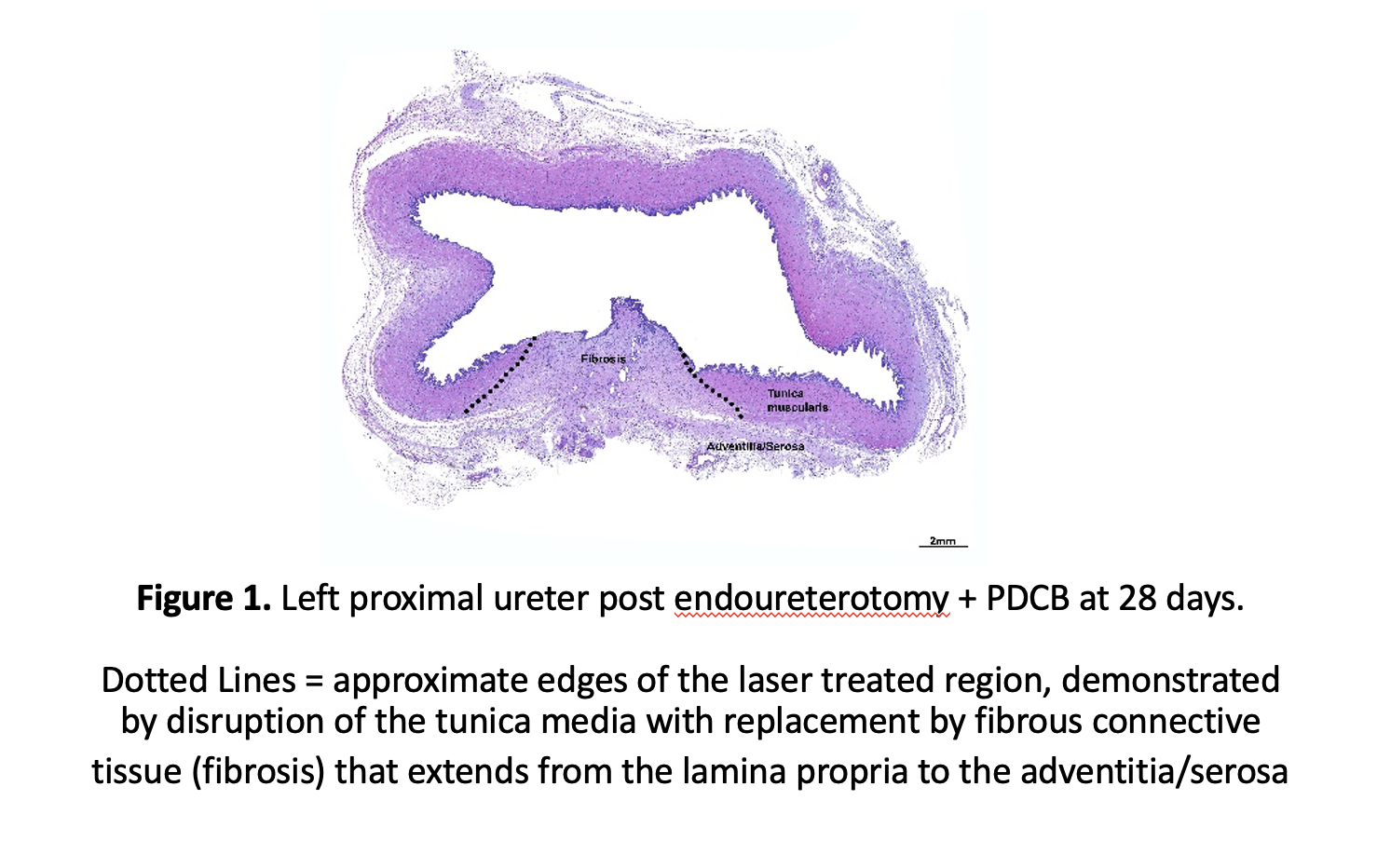Back
Introduction: Paclitaxel Drug Coated Balloons (PDCBs) have proven efficacious in the treatment of urethral stricture disease. Application of PDCBs for ureteral strictures holds promise but safety and efficacy of their use have yet to be evaluated. This study was designed to gather data concerning; pharmacokinetics, histology, safety and healing potential for the ureter after ureteral dilation with a PDCB in a porcine model.
Methods: Ureteral dilation with PDCBs was performed on three anesthetized female pigs. In all cases one ureter was treated with PDCB dilation alone while the contralateral ureter was treated first with holmium laser endoureterotomy followed by PDCB dilation. Treatments were delivered in the proximal and distal ureter on each side using either an 8mm x 50 mm or 10 mm x 50 mm PDCB. Retrograde pyelograms (RPG) were performed to assess for extravasation after dilation. Ureteral stents were placed. Animals were terminated at 10, 28 and 45 days and gross necropsy was performed. Ureteroscopy with RPGs were also performed during the 28 & 45 day termination procedure. Paclitaxel concentration was quantified from plasma, urine, and tissues. Histology was also performed on treatment site and adjacent tissue.
Results: PDCB dilation according to study protocol was successful in each case. Contrast extravasation was seen at each laser endoureterotomy/PDCB sites and none of the PDCB alone sites. All three animals survived to their scheduled termination date. RPG performed at 28 & 45 days showed complete resolution of extravasation though panureteral dilatation was seen in each case presumably related to stenting. Ureteroscopic and gross necropsy confirmed complete healing of treatment sites. Histology at 28 & 45 days showed only minimal inflammation of the PDCB alone treatment sites and complete healing of the endoureterotomy sites with otherwise minimal inflammatory response (Fig 1). Paclitaxel remained detectable in urine and target tissue for up to 45 days with plasma levels being below level of quantification.
Conclusions: PDCBs are capable of delivering paclitaxel to the upper urinary tract and do not appear to inhibit potential for healing despite significant ureteral injury among healthy female pigs. Further data is necessary prior to applying this technique to strictured ureters in human subject. SOURCE OF
Funding: Urotronic

Moderated Poster Session
Session: MP42: Trauma/Reconstruction/Diversion: Ureter (including Pyeloplasty) & Bladder Reconstruction (including Fistula), Augmentation, Substitution, Diversion
MP42-12: Tissue and Pharmacokinetic Response to Treatment with a Drug-Coated Balloon in a Porcine Ureter Model
Saturday, April 29, 2023
1:00 PM – 3:00 PM CST
Location: S505

Michael S. Borofsky, MD (he/him/his)
University of Minnesota
Poster Presenter(s)
Introduction: Paclitaxel Drug Coated Balloons (PDCBs) have proven efficacious in the treatment of urethral stricture disease. Application of PDCBs for ureteral strictures holds promise but safety and efficacy of their use have yet to be evaluated. This study was designed to gather data concerning; pharmacokinetics, histology, safety and healing potential for the ureter after ureteral dilation with a PDCB in a porcine model.
Methods: Ureteral dilation with PDCBs was performed on three anesthetized female pigs. In all cases one ureter was treated with PDCB dilation alone while the contralateral ureter was treated first with holmium laser endoureterotomy followed by PDCB dilation. Treatments were delivered in the proximal and distal ureter on each side using either an 8mm x 50 mm or 10 mm x 50 mm PDCB. Retrograde pyelograms (RPG) were performed to assess for extravasation after dilation. Ureteral stents were placed. Animals were terminated at 10, 28 and 45 days and gross necropsy was performed. Ureteroscopy with RPGs were also performed during the 28 & 45 day termination procedure. Paclitaxel concentration was quantified from plasma, urine, and tissues. Histology was also performed on treatment site and adjacent tissue.
Results: PDCB dilation according to study protocol was successful in each case. Contrast extravasation was seen at each laser endoureterotomy/PDCB sites and none of the PDCB alone sites. All three animals survived to their scheduled termination date. RPG performed at 28 & 45 days showed complete resolution of extravasation though panureteral dilatation was seen in each case presumably related to stenting. Ureteroscopic and gross necropsy confirmed complete healing of treatment sites. Histology at 28 & 45 days showed only minimal inflammation of the PDCB alone treatment sites and complete healing of the endoureterotomy sites with otherwise minimal inflammatory response (Fig 1). Paclitaxel remained detectable in urine and target tissue for up to 45 days with plasma levels being below level of quantification.
Conclusions: PDCBs are capable of delivering paclitaxel to the upper urinary tract and do not appear to inhibit potential for healing despite significant ureteral injury among healthy female pigs. Further data is necessary prior to applying this technique to strictured ureters in human subject. SOURCE OF
Funding: Urotronic

